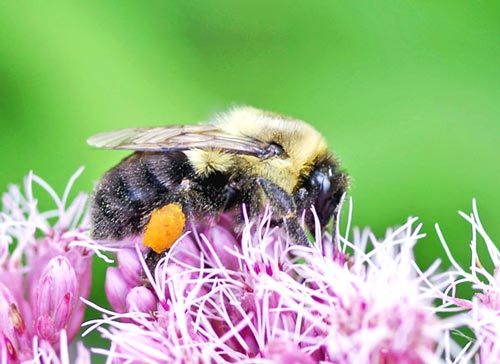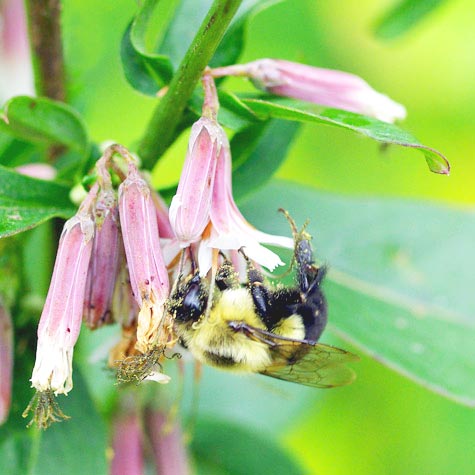Howdy, BugFans,
It looks like fun to be a bumblebee, and the BugLady can hardly pass one by without taking its picture. A BOTW in 2008 covered the lifestyle of bumblebees, and another in 2009 showed bumblebees negotiating Bottled gentian flowers. BugFan Andy, who is also a bumblebee fan, wrote and suggested an update.
[metaslider id=2923]
Here are some Fun Facts about Bumblebees:
- As a group, BBs are northern bees, tough enough to survive north of the Arctic Circle. They can thermoregulate;—producing heat by “shivering” their flight muscles without beating their wings, and retaining it via their thick, insulating hairs. They need an internal temperature of 86 degrees before they can fly. In chilly weather, queen BBs use the same “isometric” trick to incubate their eggs, warming the thorax and then sending heat to a bare spot on the underside of the abdomen; in hot weather they can get rid of excess heat that way. They have to override a built-in system to do that; BBs are designed so that the heat that’s produced in the thorax, stays in the thorax.
- Besides noting that BBs were able to pollinate certain tubular flowers that other insects couldn’t, Charles Darwin linked BB, field mouse, and cat populations (he called them humble bees, common usage in England at the time). Mice raid BB nests (which are often located in old mouse tunnels), and Darwin wrote that if cat numbers were high, mice were kept in check, and BBs throve (and so did flowers). And vice versa.
- A BB’s buzz is produced by the vibrations of its flight muscles as it flies.
- Small wings on a bulky body do not make for a very efficient flying machine. The un-aerodynamic BB essentially muscles its way through the air, flapping its wings about 200 times per second (a little slower than a honeybee’s 230 beats per second and half the speed of a mosquito).
- Honeybees (which were brought across The Pond from Europe in 1622) are key pollinators of agricultural crops, but the importance of BBs and other native bees as pollinators of a variety of beans, squashes, berries and orchard fruits is increasingly recognized. BBs pollinate 15% of U.S. crops (they fly in cooler and damper and darker weather than honeybees do), and they are now raised commercially and moved around internationally (colonies are also removed from the wild).
- And then there’s “Buzz pollination.” BBs approach a downward-facing flower, grab it, and give a little shiver while simultaneously buzzing at approximately “Middle C.” It sounds different than their in-flight buzz. The 400Hz vibration loosens the pollen grains and sends them raining down onto the BB’s furry little body. One researcher calls them “living tuning forks.” Life is Physics. Turns out BBs are the ideal pollinators for tomato, cranberry and blueberry flowers, and they’re commonly introduced into greenhouses (previously, greenhouse growers used a small hand-buzzer to imitate nature while pollinating tomatoes). Honeybees are buzz-pollination-challenged.
- Continuing in the “Life is Physics” category, as a bee flies through the air, the resistance/friction it encounters causes a small, positive electric charge to build up on its body. When it lands on a flower, the pollen grains, which have a slight negative charge, are attracted to the bee and will attach to its hairs even if the bee doesn’t actually brush against them.
- Wisconsin hosts more than 500 species of native bee, including 13 BBs. Nationwide, BBs represent 49 of about 4,000 different kinds of wild bees.
- BBs provide “Ecosystem Services.” They pollinate many wildflowers and wild fruits and berries. Although BBs themselves are generalists, some of the flowers they pollinate can’t be accessed by other bees, so their actions affect ecosystem diversity and integrity. The resulting fruits and seeds, the BBs themselves, and other invertebrates attracted to the plants, are eaten by wildlife.
[metaslider id=2918]
But, as Joni Mitchell used to sing, “Don’t it always seem to go, that you don’t know what you’ve got till it’s gone.” There are some Not-So-Fun Facts about bumblebees, too.
- While the woes of honeybees and Colony Collapse Disorder have received public attention and outcry, native bees are also disappearing. The list of adverse factors includes diseases and parasites carried by domestic bees (including imported BBs), air pollution (a University of VA study showed that gasses from cars bond with the scent molecules of flowers and make it harder for pollinators to “follow their noses.”), climate change (some may like it hot, but not BBs), pesticide use, and habitat loss and fragmentation (the current trend toward “agricultural intensification”—the removal of fence rows and natural borders—deprives bees of feeding diversity and of nectar corridors).
- Because there have been few baseline population studies of native bees, it’s hard to say how rapidly they are vanishing. It is believed that at least four or five species of BBs have experienced a severe decline. The same thing is happening in Europe.
- Some surveys do exist—in 1890, an insect enthusiast meticulously cataloged the insects around his southern Illinois home. 100+ years later, researchers could find only 54 of the 109 species of native bees he recorded.
- According to an article in a 2009 Wisconsin Natural Resources magazine, 93% of BBs found in a 1993 survey of northern Wisconsin’s cranberry growing area were Yellow-banded BBs. Less than 20 years later, YbBBs represented 1% of the BBs in the area, and the small populations seen at three Wisconsin sites were the only recorded populations in the Midwest.
Helping Bumblebees
Can we help BBs and other native bees? We certainly can.
We can census them by participating in Citizen Science efforts like the Great Sunflower Project’s Backyard Bee Count and by checking pollintor conservation to see if they have other surveys in the area.
We can plant clumps of bee-friendly, native plants that have different heights, shapes, colors and blooming seasons. Plant enough, and you’ve created a habitat, and butterflies and birds will be happy, too.
Heard of bird houses and bat houses? Here are two plans for DIY bee shelters from Dragonfly Woman: New Bee House and Bee House From Recycled Wood.
Many native bees nest in the ground or in dead trees. Can you spare a patch of lawn? Rototill or spade up a small area on the lawn’s edge and see what comes in. Leave a dead tree standing.
See Bumblebee Guide to try your hand at BB Identification. The BugLady’s BB IDs are tentative (but she’s blown away by the big Black and Gold BBs (maybe) with the crew cuts).
For more information about bees: Bee Basics—An Introduction to Our Native Bees.
The BugLady wishes that she had a dollar for every bumblebee she saw on wildflowers in southeast Wisconsin in 2013, but BugFans Tom and Joe reported a scary lack of bumblebees and other hymenopteran pollinators last summer at their locations south of the Mason Dixon line. Imagine goldenrods empty of bumblebees and windfall apples with no yellowjackets on them.
Waiting for BB weather,
The BugLady

